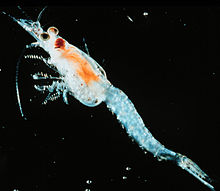
Typically bought frozen as a food source for aquarium fish, mysis shrimp (Mysida) can also be kept in an aquarium setting, mainly with the intent of using them as a living food source instead of a frozen one. This article is going to be a bit different from my last one, but will still provide the basics for getting a tank prepped for these little guys.
Tank Requirements
To get started, you’ll need a 20-30 gallon tank. While mysis shrimp rarely grow larger than an inch in length, this tank is going to serve as a hatchery, so we want a fair amount of space for the population to grow without crowding. The salinity of the saltwater should be about 1.023. You can use either a live rock with algae or some under gravel filters placed on either end of the tank, along with a powerhead on one end pointed at the other. If you’re using under gravel filters, place filter plates designed for smaller tanks over them, leaving the center of the tank bare to collect the shrimp (for example, a 30-gallon tank will use 10-gallon tank U.G. filter plates).
Keep the temperature between 75-78F (23.8-25.5C), and the pH around 8.2. Separate the tank in half with a mesh that will allow the eggs to pass through, but not the adults. Let it sit for a while to establish filtration, especially if you use the live rock, which requires at least 3-4 weeks to fully filter the tank. You’ll also want a light setup that provides 8 hours of darkness, as mysis shrimp mate at night.
General Care
Once the tank has been set up and filtered, it’s time to add the shrimp. You’ll want at least 20-30 adult mysis shrimp to start, but you could add 100 if you so choose. Put them on the side the powerhead is attached to; it will push the eggs through the mesh onto the other side of the tank. As the eggs hatch and grow into adulthood, they can be transferred back over. “Why are we doing this?” you may be asking. Well, mysis shrimp are not only carnivorous, they are also highly cannibalistic, and won’t hesitate to dine on their own eggs. This is why we’ve set up an automatic separator.
Feed them twice a day on a diet of brine shrimp, which you can either buy or set up another hatchery-style tank. If you aren’t able to get brine shrimp right off the bat, you could sacrifice a few mysis shrimp eggs until then, though I would recommend getting brine shrimp ASAP. When it’s time to harvest the shrimp, simply sweep a net through the bare center section of the tank on the adult side. Make sure at least 20% of the population remains in the tank to keep it self-sustaining.
For further information, or any questions you may have, contact your local aquarium.
-William